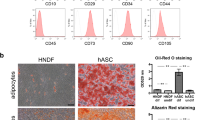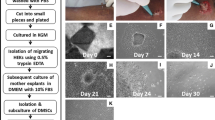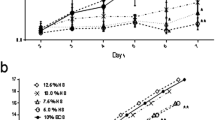Abstract
Recent advances in wound healing have made cell therapy a potential approach for the treatment of various types of skin defects such as trauma, burns, scars and diabetic leg ulcers. Cultured keratinocytes have been applied to burn patients since 1981. Patients with acute and chronic wounds can be treated with autologous/allograft cultured keratinocytes. There are various methods for cultivation of epidermal keratinocytes used in cell therapy. One of the important properties of an efficient cell therapy is the preservation of epidermal stem cells. Mesenchymal Stem Cells (MSCs) are major regulatory cells involved in the acceleration of wound healing via induction of cell proliferation, angiogenesis and stimulating the release of paracrine signaling molecules. Considering the beneficial effects of MSCs on wound healing, the main aim of the present study is investigating paracrine effects of Adipose-derived Mesenchymal Stem Cell (Ad-MSCs) on cultivation of keratinocytes with focusing on preservation of stem cells and their differentiation process. We further introduced a new approach for culturing isolated keratinocytes in vitro in order to generate epidermal keratinocyte sheets without using a feeder layer. To do so, Ad-MSC conditioned medium was applied as an alternative to commercial media for keratinocyte cultivation. In this study, the expression of several stem/progenitor cell (P63, K19 and K14) and differentition (K10, IVL and FLG) markers was examined using real time PCR on days 7, 14 and 21 of culture in keratinocytes in Ad-MSC conditioned medium. P63 and α6 integrin expression was also evaluated via flow cytometry. The results were compared with control group including keratinocytes cultured in EpiLife medium and our data indicated that this Ad-MSC conditioned medium is a good alternative for keratinocyte cultivation and producing epidermal sheets for therapeutic and clinical purposes. The reasons are the expression of stem cell and differentiation markers and overcoming the requirement for feeder layer which leads to a xenograft-free transplantation. Besides, this approach has low cost and is easier to perform. However, more in vitro and in vivo experiments as well as safety evaluation required before clinical applications.








Similar content being viewed by others
References
Atiyeh BS, Costagliola M (2007) Cultured epithelial autograft (CEA) in burn treatment: three decades later. Burns 33:405–413
Auxenfans C, Thépot A, Justin V, Hautefeuille A, Shahabeddin L, Damour O, Hainaut P (2009) Characterisation of human fibroblasts as keratinocyte feeder layer using p63 isoforms status. Biomed Mater Eng 19:365–372
Barrandon Y, Green H (1987) Three clonal types of keratinocyte with different capacities for multiplication. Proc Natl Acad Sci USA 84:2302–2306
Bisson F, Rochefort É, Lavoie A, Larouche D, Zaniolo K, Simard-Bisson C, Damour O, Auger FA, Guérin SL, Germain L (2013) Irradiated human dermal fibroblasts are as efficient as mouse fibroblasts as a feeder layer to improve human epidermal cell culture lifespan. Int J Mol Sci 14:4684–4704
Boyce ST (2001) Design principles for composition and performance of cultured skin substitutes. Burns 27:523–533
Bullock AJ, Higham MC, MacNeil S (2006) Use of human fibroblasts in the development of a xenobiotic-free culture and delivery system for human keratinocytes. Tissue Eng 12:245–255
Byrne C, Tainsky M, Fuchs E (1994) Programming gene expression in developing epidermis. Development 120:2369–2383
Chen L, Tredget EE, Wu PYG, Wu Y (2008) Paracrine factors of mesenchymal stem cells recruit macrophages and endothelial lineage cells and enhance wound healing. PLoS ONE 3:e1886
Cirodde A, Leclerc T, Jault P, Duhamel P, Lataillade J-J, Bargues L (2011) Cultured epithelial autografts in massive burns: a single-center retrospective study with 63 patients. Burns 37:964–972
Damanhuri M, Boyle J, Enoch S (2011) Advances in tissue-engineered skin substitutes. Wounds Int 2:27–34
De Corte P, Verween G, Verbeken G, Rose T, Jennes S, De Coninck A, Roseeuw D, Vanderkelen A, Kets E, Haddow D (2012) Feeder layer-and animal product-free culture of neonatal foreskin keratinocytes: improved performance, usability, quality and safety. Cell Tissue Bank 13:175–189
Dragúňová J, Kabát P, Koller J, Jarabinská V (2012) Experience gained during the long term cultivation of keratinocytes for treatment of burns patients. Cell Tissue Bank 13:471–478
Esteban-Vives R, Young M, Over P, Schmelzer E, Corcos A, Ziembicki J, Gerlach J (2015) In vitro keratinocyte expansion for cell transplantation therapy is associated with differentiation and loss of basal layer derived progenitor population. Differentiation 89:137–145
Falanga V, Iwamoto S, Chartier M, Yufit T, Butmarc J, Kouttab N, Shrayer D, Carson P (2007) Autologous bone marrow-derived cultured mesenchymal stem cells delivered in a fibrin spray accelerate healing in murine and human cutaneous wounds. Tissue Eng 13:1299–1312
Franke WW, Grund C, Kuhn C, Jackson BW, Illmensee K (1982) Formation of cytoskeletal elements during mouse embryogenesis. Differentiation 23:43–59
Fuchs E (2008) Skin stem cells: rising to the surface. J Cell Biol 180:273–284
Fusenig NE, Worst PKM (1974) Mouse epidermal cell cultures I. Isolation and cultivation of epidermal cells from adult mouse skin. J Invest Dermatol 63:187–193
Gazel A, Ramphal P, Rosdy M, Tornier C, Hosein N, Lee B, Tomic-Canic M, Blumenberg M (2003) Transcriptional profiling of epidermal keratinocytes: comparison of genes expressed in skin, cultured keratinocytes, and reconstituted epidermis, using large DNA microarrays. J Invest Dermatol 121:1459–1468
Gerlach J, Wolf SE, Johnen C, Hartmann B (2008) Innovative regenerative medicine approaches to skin cell-based therapy for patients with burn injuries. In: Gerlach J (ed) Principles of regenerative medicine No 76. Elsevier, Burlington, pp 1298–1321
Germain L (2002) Engineering human tissues for in vivo applications: storage and translational issues for tissue repair and regeneration. In: Engineering in Medicine and Biology, 2002. 24th Annual Conference and the Annual Fall Meeting of the Biomedical Engineering Society EMBS/BMES Conference, 2002. Proceedings of the Second Joint. IEEE, pp 882–883
Gomez-Sanchez JA, Gomis-Coloma C, Morenilla-Palao C, Peiro G, Serra E, Serrano M, Cabedo H (2013) Epigenetic induction of the Ink4a/Arf locus prevents Schwann cell overproliferation during nerve regeneration and after tumorigenic challenge. Brain 136:2262–2278
Gozgit JM, Pentecost BT, Marconi SA, Ricketts-Loriaux RSJ, Otis CN, Arcaro KF (2007) PLD1 is overexpressed in an ER-negative MCF-7 cell line variant and a subset of phospho-Akt-negative breast carcinomas. Br J Cancer 97:809–817
Green H (2008) The birth of therapy with cultured cells. BioEssays 30:897–903
Guerra L, Primavera G, Raskovic D, Pellegrini G, Golisano O, Bondanza S, Kuhn S, Piazza P, Luci A, Atzori F (2004) Permanent repigmentation of piebaldism by erbium: YAG laser and autologous cultured epidermis. Br J Dermatol 150:715–721
Gurtner GC, Werner S, Barrandon Y, Longaker MT (2008) Wound repair and regeneration. Nature 453:314–321
Hartmann B, Ekkernkamp A, Johnen C, Gerlach JC, Belfekroun C, Küntscher MV (2007) Sprayed cultured epithelial autografts for deep dermal burns of the face and neck. Ann Plast Surg 58:70–73
Hocking AM, Gibran NS (2010) Mesenchymal stem cells: paracrine signaling and differentiation during cutaneous wound repair. Exp Cell Res 316:2213–2219
Ishimoto SI, Ishibashi T, Bottaro DP, Kaga K (2002) Direct application of keratinocyte growth factor, basic fibroblast growth factor and transforming growth factor-α during healing of tympanic membrane perforation in glucocorticoid-treated rats. Acta Otolaryngol 122:468–473
Izumi K, Tobita T, Feinberg SE (2007) Isolation of human oral keratinocyte progenitor/stem cells. J Dent Res 86:341–346
Jones I, Currie L, Martin R (2002) A guide to biological skin substitutes. Br J Plast Surg 55:185–193
Jubin K, Martin Y, Lawrence-Watt DJ, Sharpe JR (2011) A fully autologous co-culture system utilising non-irradiated autologous fibroblasts to support the expansion of human keratinocytes for clinical use. Cytotechnology 63:655–662
Kadoya K, Amano S, Nishiyama T, Inomata S, Tsunenaga M, Kumagai N, Matsuzaki K (2014) Changes in the expression of epidermal differentiation markers at sites where cultured epithelial autografts were transplanted onto wounds from burn scar excision. Int Wound J 13(3):412–417
Kim DS, Cho HJ, Choi HR, Kwon SB, Park KC (2004) Isolation of human epidermal stem cells by adherence and the reconstruction of skin equivalents. Cell Mol Life Sci C 61:2774–2781
Kim W-S, Park B-S, Sung J-H, Yang J-M, Park S-B, Kwak S-J, Park J-S (2007) Wound healing effect of adipose-derived stem cells: a critical role of secretory factors on human dermal fibroblasts. J Dermatol Sci 48:15–24
Kjartansson J, Dalsgaard C-J, Haegerstrand A, Bjarnason R, Jakobsson B (1991) Transplantation of cultured autologous epithelium after meningococcal septicaemia in a 4-year-old with 35% skin loss. Scand J Plast Reconstr Surg Hand Surg 25:291–293
Kolev V, Mandinova A, Guinea-Viniegra J, Hu B, Lefort K, Lambertini C, Neel V, Dummer R, Wagner EF, Dotto GP (2008) EGFR signalling as a negative regulator of Notch1 gene transcription and function in proliferating keratinocytes and cancer. Nat Cell Biol 10:902–911
Koster MI (2010) p63 in skin development and ectodermal dysplasias. J Invest Dermatol 130:2352–2358
Larderet G, Fortunel NO, Vaigot P, Cegalerba M, Maltere P, Zobiri O, Gidrol X, Waksman G, Martin MT (2006) Human side population keratinocytes exhibit long-term proliferative potential and a specific gene expression profile and can form a pluristratified epidermis. Stem Cells 24:965–974
Laurikkala J, Mikkola ML, James M, Tummers M, Mills AA, Thesleff I (2006) p63 regulates multiple signalling pathways required for ectodermal organogenesis and differentiation. Development 133:1553–1563
Lee EY, Xia Y, Kim W, Kim MH, Kim TH, Kim KJ, Park B, Sung J (2009) Hypoxia-enhanced wound-healing function of adipose-derived stem cells: increase in stem cell proliferation and up-regulation of VEGF and bFGF. Wound Repair Regen 17:540–547
Lee SH, Jin SY, Song JS, Seo KK, Cho KH (2012) Paracrine effects of adipose-derived stem cells on keratinocytes and dermal fibroblasts. Ann Dermatol 24:136–143
Liu P, Deng Z, Han S, Liu T, Wen N, Lu W, Geng X, Huang S, Jin Y (2008) Tissue-engineered skin containing mesenchymal stem cells improves burn wounds. Artif Organs 32:925–931
Lootens L, Brusselaers N, Beele H, Monstrey S (2013) Keratinocytes in the treatment of severe burn injury: an update. Int Wound J 10:6–12
Maxson S, Lopez EA, Yoo D, Danilkovitch-Miagkova A, LeRoux MA (2012) Concise review: role of mesenchymal stem cells in wound repair. Stem Cells Transl Med 1:142–149
Mcheik JN, Barrault C, Levard G, Morel F, Bernard FX, Lecron JC (2014) Epidermal healing in burns: autologous keratinocyte transplantation as a standard procedure: update and perspective. Plast Reconstr Surgery-Global Open 2:e218
Michel M, Torok N, Godbout M-J, Lussier M, Gaudreau P, Royal A, Germain L (1996) Keratin 19 as a biochemical marker of skin stem cells in vivo and in vitro: keratin 19 expressing cells are differentially localized in function of anatomic sites, and their number varies with donor age and culture stage. J Cell Sci 109:1017–1028
Mommers JM, Goossen JW, van de Kerkhof PCM, van Erp PEJ (2000) Novel functional multiparameter flow cytometric assay to characterize proliferation in skin. Cytometry 42:43–49
Moustafa M, Simpson C, Glover M, Dawson RA, Tesfaye S, Creagh FM, Haddow D, Short R, Heller S, MacNeil S (2004) A new autologous keratinocyte dressing treatment for non-healing diabetic neuropathic foot ulcers. Diabet Med 21:786–789
Naderi-Meshkin H, Matin MM, Heirani-Tabasi A, Mirahmadi M, Irfan-Maqsood M, Edalatmanesh MA, Shahriyari M, Ahmadiankia N, Moussavi NS, Bidkhori HR, Bahrami AR (2016) Injectable hydrogel delivery plus preconditioning of mesenchymal stem cells: exploitation of SDF-1/CXCR4 axis toward enhancing the efficacy of stem cells’ homing. Cell Biol Int 40:730–741
Nair RP, Krishnan LK (2013) Identification of p63 + keratinocyte progenitor cells in circulation and their matrix-directed differentiation to epithelial cells. Stem Cell Res Ther 4:1
Nakajima R, Takeda S (2014) Efficient fabrication of epidermal cell sheets using γ-secretase inhibitor. J Dermatol Sci 76:246–254
O’Connor N, Mulliken J, Banks-Schlegel S, Kehinde O, Green H (1981) Grafting of burns with cultured epithelium prepared from autologous epidermal cells. Lancet 317:75–78
Ojeh N, Pastar I, Tomic-Canic M, Stojadinovic O (2015) Stem cells in skin regeneration, wound healing, and their clinical applications. Int J Mol Sci 16:25476–25501
Papini S, Cecchetti D, Campani D, Fitzgerald W, Grivel JC, Chen S, Margolis L, Revoltella RP (2003) Isolation and clonal analysis of human epidermal keratinocyte stem cells in long-term culture. Stem Cells 21:481–494
Peck MD (2011) Epidemiology of burns throughout the world. Part I: distribution and risk factors. Burns 37:1087–1100
Pellegrini G, Ranno R, Stracuzzi G, Bondanza S, Guerra L, Zambruno G, Micali G, De Luca M (1999) The control of epidermal stem cells (holoclones) in the treatment of massive full-thickness burns with autologous keratinocytes cultured on fibrin1. Transplantation 68:868–879
Pellegrini G, Dellambra E, Golisano O, Martinelli E, Fantozzi I, Bondanza S, Ponzin D, McKeon F, De Luca M (2001) p63 identifies keratinocyte stem cells. Proc Natl Acad Sci USA 98:3156–3161
Pontiggia L, Biedermann T, Meuli M, Widmer D, Böttcher-Haberzeth S, Schiestl C, Schneider J, Braziulis E, Montaño I, Meuli-Simmen C (2009) Markers to evaluate the quality and self-renewing potential of engineered human skin substitutes in vitro and after transplantation. J Invest Dermatol 129:480–490
Presland RB, Kuechle MK, Lewis SP, Fleckman P, Dale BA (2001) Regulated expression of human filaggrin in keratinocytes results in cytoskeletal disruption, loss of cell–cell adhesion, and cell cycle arrest. Exp Cell Res 270:199–213
Racila D, Winter M, Said M, Tomanek-Chalkley A, Wiechert S, Eckert RL, Bickenbach JR (2011) Transient expression of OCT4 is sufficient to allow human keratinocytes to change their differentiation pathway. Gene Ther 18:294–303
Rehman J, Traktuev D, Li J, Merfeld-Clauss S, Temm-Grove CJ, Bovenkerk JE, Pell CL, Johnstone BH, Considine RV, March KL (2004) Secretion of angiogenic and antiapoptotic factors by human adipose stromal cells. Circulation 109:1292–1298
Rheinwatd JG, Green H (1975) Seria cultivation of strains of human epidemal keratinocytes: the formation keratinizin colonies from single cell is. Cell 6:331–343
Scuderi N, Anniboletti T, Carlesimo B, Onesti MG (2009) Clinical application of autologous three-cellular cultured skin substitutes based on esterified hyaluronic acid scaffold: our experience. In Vivo 23:991–1003
Senoo M, Pinto F, Crum CP, McKeon F (2007) p63 is essential for the proliferative potential of stem cells in stratified epithelia. Cell 129:523–536
Smith AN, Willis E, Chan VT, Muffley LA, Isik FF, Gibran NS, Hocking AM (2010) Mesenchymal stem cells induce dermal fibroblast responses to injury. Exp Cell Res 316:48–54
Sun T, Higham M, Layton C, Haycock J, Short R, MacNeil S (2004) Developments in xenobiotic-free culture of human keratinocytes for clinical use. Wound repair Regen 12:626–634
Sun BK, Siprashvili Z, Khavari PA (2014) Advances in skin grafting and treatment of cutaneous wounds. Science 6212:941–945
Supp DM, Boyce ST (2005) Engineered skin substitutes: practices and potentials. Clin Dermatol 23:403–412
Suzuki D, Senoo M (2012) Increased p63 phosphorylation marks early transition of epidermal stem cells to progenitors. J Invest Dermatol 132:2461
Tan KKB, Salgado G, Connolly JE, Chan JKY, Lane EB (2014) Characterization of fetal keratinocytes, showing enhanced stem cell-like properties: a potential source of cells for skin reconstruction. Stem Cell Rep 3:324–338
Teng M, Huang Y, Zhang H (2014) Application of stems cells in wound healing—an update. Wound Repair Regen 22:151–160
Truong AB, Khavari PA (2007) Control of keratinocyte proliferation and differentiation by p63. Cell Cycle 6:295–299
Umeki H, Tokuyama R, Ide S, Okubo M, Tadokoro S, Tezuka M, Tatehara S, Satomura K (2014) Leptin promotes wound healing in the oral mucosa. PLoS ONE 9:e101984
Webb A, Li A, Kaur P (2004) Location and phenotype of human adult keratinocyte stem cells of the skin. Differentiation 72:387–395
Wikramanayake TC, Stojadinovic O, Tomic-Canic M (2014) Epidermal differentiation in barrier maintenance and wound healing. Adv Wound Care 3:272–280
Wong M, Chua A, Tan BK (2013) Cultured epithelial autografts for the coverage of large wounds: minimizing skin graft donor sites in the sick patient. Eur J Plast Surg 36:371–376
You HJ, Han SK (2014) Cell therapy for wound healing. J Korean Med Sci 29:311–319
Zuliani T, Saiagh S, Knol A-C, Esbelin J, Dréno B (2013) Fetal fibroblasts and keratinocytes with immunosuppressive properties for allogeneic cell-based wound therapy. PLoS ONE 8:e70408
Acknowledgement
The authors are grateful to Sonia Iranpour, Mahboubeh Kazemi and Asieh Heirani-Tabasi for their technical assistance.
Funding
This study was funded by a Grant from ACECR-Khorasan Razavi Branch (12.987).
Author information
Authors and Affiliations
Corresponding authors
Ethics declarations
Conflict of interest
The authors declare that there are no financial or personal conflict of interest.
Ethical approval
This article does not contain any studies with human participants or animals performed by any of the authors.
Rights and permissions
About this article
Cite this article
Hassanzadeh, H., Matin, M.M., Naderi-Meshkin, H. et al. Using paracrine effects of Ad-MSCs on keratinocyte cultivation and fabrication of epidermal sheets for improving clinical applications. Cell Tissue Bank 19, 531–547 (2018). https://doi.org/10.1007/s10561-018-9702-5
Received:
Accepted:
Published:
Issue Date:
DOI: https://doi.org/10.1007/s10561-018-9702-5




